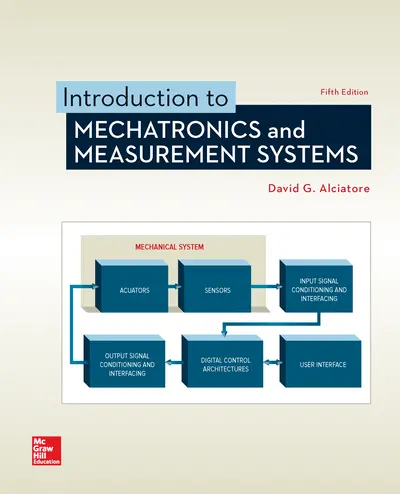My Account Details

ISBN10: 1259892344 | ISBN13: 9781259892349

* The estimated amount of time this product will be on the market is based on a number of factors, including faculty input to instructional design and the prior revision cycle and updates to academic research-which typically results in a revision cycle ranging from every two to four years for this product. Pricing subject to change at any time.
Instructor Information
Quick Actions (Only for Validated Instructor Accounts):
Introduction to Mechatronics and Measurement Systems, Fifth Edition, provides comprehensive and accessible coverage of the field of mechatronics for mechanical, electrical and aerospace engineering majors. The author presents a concise review of electrical circuits, solid-state devices, digital circuits, and motors- all of which are fundamental to understanding mechatronic systems.
Mechatronics design considerations are presented throughout the text, and in "Design Example" features. The text's numerous illustrations, examples, class discussion items, and chapter questions & exercises provide an opportunity to understand and apply mechatronics concepts to actual problems encountered in engineering practice. This text has been tested over several years to ensure accuracy.
Introduction to Mechatronics and Measurement Systems, Fifth Edition - is a multifaceted resource which is designed to serve as a text for modern instrumentation and measurements courses, hybrid electrical and mechanical engineering courses replacing traditional circuits and instrumentation courses, as well as for stand-alone mechatronics courses, or the first course in a mechatronics sequence. It can also work for hybrid courses, providing an opportunity to reduce the number of credit hours in a typical mechanical engineering curriculum. Written by the academic award winning author and mechanical engineering professor, Dr. David G. Alciatore.
The author's webpage (linked to from OLC) has additional computer files and resources, including MATLAB examples, videos demonstrations, and lab exercises.
Accessibility
Creating accessible products is a priority for McGraw Hill. We make accessibility and adhering to WCAG AA guidelines a part of our day-to-day development efforts and product roadmaps.
For more information, visit our accessibility page, or contact us at accessibility@mheducation.com
Need support? We're here to help - Get real-world support and resources every step of the way.